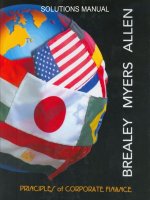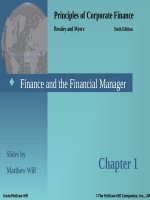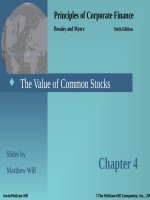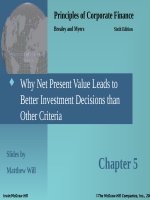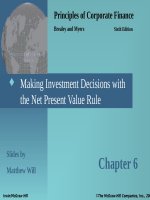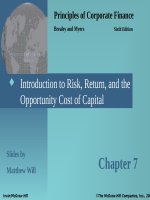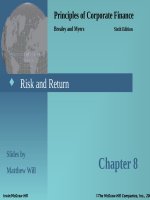Principles of cororate finance 6th brealey myers chapter 02
Bạn đang xem bản rút gọn của tài liệu. Xem và tải ngay bản đầy đủ của tài liệu tại đây (306.75 KB, 23 trang )
Principles of Corporate Finance
Brealey and Myers
Sixth Edition
Present Value and The Opportunity
Cost of Capital
Slides by
Matthew Will
Irwin/McGraw Hill
Chapter 2
©The McGraw-Hill Companies, Inc., 200
2- 2
Topics Covered
Present Value
Net Present Value
NPV Rule
ROR Rule
Opportunity Cost of Capital
Managers and the Interests of Shareholders
Irwin/McGraw Hill
©The McGraw-Hill Companies, Inc., 200
2- 3
Present Value
Present Value
Discount Factor
Value today of a
future cash
flow.
Present value of
a $1 future
payment.
Discount Rate
Interest rate used
to compute
present values of
future cash flows.
Irwin/McGraw Hill
©The McGraw-Hill Companies, Inc., 200
2- 4
Present Value
Present Value = PV
PV = discount factor × C1
Irwin/McGraw Hill
©The McGraw-Hill Companies, Inc., 200
2- 5
Present Value
Discount Factor = DF = PV of $1
DF =
1
(1+ r ) t
Discount Factors can be used to compute the present value of
any cash flow.
Irwin/McGraw Hill
©The McGraw-Hill Companies, Inc., 200
2- 6
Valuing an Office Building
Step 1: Forecast cash flows
Cost of building = C0 = 350
Sale price in Year 1 = C1 = 400
Step 2: Estimate opportunity cost of capital
If equally risky investments in the capital market
offer a return of 7%, then
Cost of capital = r = 7%
Irwin/McGraw Hill
©The McGraw-Hill Companies, Inc., 200
2- 7
Valuing an Office Building
Step 3: Discount future cash flows
PV =
C1
(1+r )
=
400
(1+.07 )
= 374
Step 4: Go ahead if PV of payoff exceeds investment
NPV = −350 + 374 = 24
Irwin/McGraw Hill
©The McGraw-Hill Companies, Inc., 200
2- 8
Net Present Value
NPV = PV - required investment
C1
NPV = C0 +
1+ r
Irwin/McGraw Hill
©The McGraw-Hill Companies, Inc., 200
2- 9
Risk and Present Value
Higher risk projects require a higher rate of return.
Higher required rates of return cause lower PVs.
PV of C1 = $400 at 7%
400
PV =
= 374
1 + .07
Irwin/McGraw Hill
©The McGraw-Hill Companies, Inc., 200
2- 10
Risk and Present Value
PV of C1 = $400 at 12%
400
PV =
= 357
1 + .12
PV of C1 = $400 at 7%
400
PV =
= 374
1 + .07
Irwin/McGraw Hill
©The McGraw-Hill Companies, Inc., 200
2- 11
Rate of Return Rule
Accept investments that offer rates of return in excess of
their opportunity cost of capital
Irwin/McGraw Hill
©The McGraw-Hill Companies, Inc., 200
2- 12
Rate of Return Rule
Accept investments that offer rates of return in excess of
their opportunity cost of capital.
Example
In the project listed below, the foregone investment
opportunity is 12%. Should we do the project?
profit
400,000 − 350,000
Return =
=
= .14 or 14%
investment
350,000
Irwin/McGraw Hill
©The McGraw-Hill Companies, Inc., 200
2- 13
Net Present Value Rule
Accept investments that have positive net present value
Irwin/McGraw Hill
©The McGraw-Hill Companies, Inc., 200
2- 14
Net Present Value Rule
Accept investments that have positive net present value.
Example
Suppose we can invest $50 today and receive $60
in one year. Should we accept the project given a
10% expected return?
60
NPV = -50 +
= $4.55
1.10
Irwin/McGraw Hill
©The McGraw-Hill Companies, Inc., 200
2- 15
Opportunity Cost of Capital
Example
You may invest $100,000 today. Depending on the
state of the economy, you may get one of three
possible cash payoffs:
Economy Slump Normal Boom
Payoff
$80,000 110,000 140,000
80,000 + 100,000 + 140,000
Expected payoff = C1 =
= $110,000
3
Irwin/McGraw Hill
©The McGraw-Hill Companies, Inc., 200
2- 16
Opportunity Cost of Capital
Example - continued
The stock is trading for $95.65. Depending on the
state of the economy, the value of the stock at the
end of the year is one of three possibilities:
Economy Slump Normal Boom
Stock Price $80
110
140
Irwin/McGraw Hill
©The McGraw-Hill Companies, Inc., 200
2- 17
Opportunity Cost of Capital
Example - continued
The stocks expected payoff leads to an expected
return.
80 + 100 + 140
Expected payoff = C1 =
= $110
3
expected profit 110 − 95.65
Expected return =
=
= .15 or 15%
investment
95.65
Irwin/McGraw Hill
©The McGraw-Hill Companies, Inc., 200
2- 18
Opportunity Cost of Capital
Example - continued
Discounting the expected payoff at the expected
return leads to the PV of the project.
110,000
PV =
= $95,650
1.15
Irwin/McGraw Hill
©The McGraw-Hill Companies, Inc., 200
2- 19
Investment vs. Consumption
Some people prefer to consume now. Some prefer to invest
now and consume later. Borrowing and lending allows us
to reconcile these opposing desires which may exist within
the firm’s shareholders.
Irwin/McGraw Hill
©The McGraw-Hill Companies, Inc., 200
2- 20
Investment vs. Consumption
income in period 1
100
A■
80
Some investors will prefer A
and others B
60
B■
40
20
20
Irwin/McGraw Hill
40
60
income in period 0
80
100
©The McGraw-Hill Companies, Inc., 200
2- 21
Investment vs. Consumption
The grasshopper (G) wants to consume
now. The ant (A) wants to wait. But
each is happy to invest. A prefers to
invest 14%, moving up the red arrow,
rather than at the 7% interest rate. G
invests and then borrows at 7%, thereby
transforming $100 into $106.54 of
immediate consumption. Because of
the investment, G has $114 next year to
pay off the loan. The investment’s NPV
is $106.54-100 = +6.54
Irwin/McGraw Hill
©The McGraw-Hill Companies, Inc., 200
2- 22
Investment vs. Consumption
Dollars
Later
A invests $100 now
and consumes $114
next year
114
107
The grasshopper (G) wants to consume now.
The ant (A) wants to wait. But each is happy
to invest. A prefers to invest 14%, moving up
the red arrow, rather than at the 7% interest
rate. G invests and then borrows at 7%,
thereby transforming $100 into $106.54 of
immediate consumption. Because of the
investment, G has $114 next year to pay off
the loan. The investment’s NPV is $106.54100 = +6.54
G invests $100 now,
borrows $106.54 and
consumes now.
100
Irwin/McGraw Hill
106.54
Dollars
Now
©The McGraw-Hill Companies, Inc., 200
2- 23
Managers and Shareholder Interests
Tools to Ensure Management Responsiveness
Subject managers to oversight and review by
specialists.
Internal competition for top level jobs that are
appointed by the board of directors.
Financial incentives such as stock options.
Irwin/McGraw Hill
©The McGraw-Hill Companies, Inc., 200

